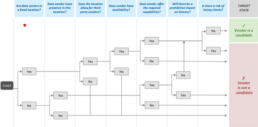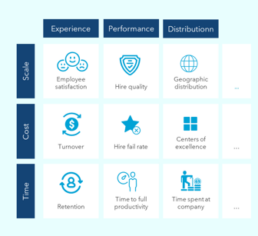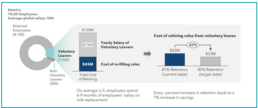Introduction
More than fifty percent of M&A deals fail to be accretive or increase shareholder’s returns. Notably, this figure has not changed in thirty years. The major culprit is a misunderstanding of synergies. Broadly speaking, there are three types of hard and soft synergies that can be called upon to drive returns during an integration:
1. Hard Synergies (Cost synergies)
2. Hybrid Synergies (Capital synergies)
3. Soft Synergies (Revenue synergies)
Hard synergies include cost and sometimes capital synergies, including streamlining of physical real estate and overhead, vendor consolidation, and headcount synergies. Cost synergies, in particular, are quick wins for an integration, as the effects are generally immediate to a company’s balance sheet: they are typically easier to estimate and more reliably quantified. Cost synergies also are more easily rationalized in the short term and therefore more often used to justify an M&A transaction. In fact, sixty-two percent of COOs cited cost synergies as the number-one reason for ultimately supporting a transaction. 1
Particularly in private equity fueled transactions, now making up thirty-two percent of all M&A deals in the last two years, (up 108 percent in the last year alone) the focus is on reducing costs in a short time horizons. Over the last decade, these cost optimization practices that increase IRR evolved into systemized processes with formulaic, measurable results. However, cost cutting is only one part of the picture of how integration success can be measured.
Soft synergies include product hybridization and go-to-market implementation, geographic expansion, culture, and talent diversification. These generally unfold over a much longer time horizon and can also be optimized through using a data-driven approach, leveraging KPIs and tracking metrics. A common misconception is that revenue synergies are illusive or “icing on the cake”, primarily because they are more challenging to quantify. However, applying a value driven approach to soft revenue synergies can help. Specifically, leveraging comprehensive and forward-looking data analytics solutions to M&A transactions facilitates two critical areas for success: First, it encourages the unearthing of additional synergies pathways not generally considered – establishing a systemized approach to leave no stone unturned; second, it allows for an effective tracking of progress to steer integration efforts themselves.
Opportunities to be Data-driven
In assessing the common pitfalls of many large-scale mergers and buyouts, six critical areas to leverage data to drive integration success can be identified.
1. Leverage advanced analytics to reduce time spent in due diligence
Time and cost intensive pre-deal target scoping and value analysis is often done on an as-needed basis with companies screening a pre-defined set of potential candidates. Both the pool of candidates sent to review, as well as the quality of the assessments themselves are often incomplete.
Applying a data forward approach to the due diligence process reduces the time and costs of pre-close, while simultaneously increasing the breadth of in-scope targets, thereby freeing up time for more hands-on post close integration activities.
Specifically, automated target screening tools allow web interfaces to quickly develop customized search criteria. Analyst teams can identify thousands of targets and shortlisting using weighted criteria and Natural Language Processing (NLP), thus reducing time spent from traditional methods by ~50 to 60%. 3
Additionally, targeted AI-powered apps allow M&A teams to rapidly ingest and normalize large data sets, with the processing power to evaluate multiple potential scenarios. Armed with this information, C-suite leaders and their teams can identify more sources of value from the transactions they execute, while predicting more accurately the value to be attained. These systems work by increasing the number of factors that are screened. Increasing the number of key success criteria reduces the chance of integration failure, while providing a more holistic view of “what good looks like.”
2. Bespoke technical infrastructure due diligence
Integrations are often conducted to expand a product or service offering in a particular segment of the market. In these instances, the respective organizations will, to varying degrees, become one … or at least that is the goal! This may likely involve integration of real estate, applications and internal systems, branding, and product alignment across the value chain.
The exact look and feel of how companies achieve a joint existence depends on the specific goals outlined during the early sourcing stage. Generally, customer-facing or publicly visible changes are prioritized during the due diligence and strategic planning phase of the integration, with joint go-to-market approach earning significant attention. Though less visible to executives, investors, and customers, the integration approach for technical infrastructure between the organizations is the bedrock on top of which all other integration considerations stand. It must therefore be prioritized early, during the due diligence phase of an integration.
The respective organizational setup of two companies in a similar segment of the market may appear congruous from a high level. It may seem that infrastructural differences are inconsequential. In reality however, these differences are generally quite intentional, with repercussions that are more significant than they first appear.
In a recent integration managed by Kepler Cannon, it was discovered several months post-close that the customer facing products and corresponding data centers of the acquired company operated under vastly different conditions than that of the acquiree. What first appeared to be a significant cost saving opportunity in combining the companies’ client facing infrastructure was soon found to be a potentially destructive exercise that would cost the firm millions of dollars in operational disruption and latency slowdown. Specifically, the acquired company’s front-office solutions required a specialized connectivity, reliability, and scalability model in order to satisfy table stakes demands of customers and infrastructure requirements. In order to re-baseline, all customer-facing products and their corresponding data centers were reviewed to assess alternative operating model solutions, a process that though ultimately saved the integration, took extensive groundwork and delayed other necessary integration activities.
The lessons learned were clear: It is necessary to look under the hood and evaluate operational and performance metrics as early as possible during the integration lifecycle, before outlining an approach to combining two companies’ technical infrastructure. Such a comprehensive approach requires more than just looking at the data at face value; rather, data itself must be contextualized and benchmarked to achieve a “so-what” and to understand the full consequences of various proposed solutions. Using a framework-driven approach to define each company’s design principles, organizational setup, and unique infrastructure requirements during due diligence will allow teams to get a sense of what integration approaches are feasible and whether a go decision makes sense under the circumstances. Assessing this data after close is often too late, given the complex web of dependencies that begin to span out as soon as the integration officially commences.
Exhibit 1. Infrastructure Integration Assessment
3. Data-driven system for recognizing and maintaining talent
Retaining critical talent and ensuring the right people are matched to various roles are fundamentals of a successful merger. Gaining access to highly skilled employees is often a top driver of many integrations; conversely mismanaging talent issues can seriously affect the success of even a relatively straightforward transaction. Because talent contains an inherent human element, it is challenging to measure through objective means; however, it is critical to do one’s best.
Often coined “merger causalities” an increase in attrition is common during an integration. On Average, attrition increases by fifteen percent in the first year post-close, but this varies considerably by industry and under different market climates.4 Many employees, for example, may prefer the culture of working at a smaller organization, or they may fear department cuts. Others may be swayed by influential leavers. Given this normal uptick in attrition, it can often be challenging to distinguish an on-track talent integration from an at-risk one.
If enough key legacy talent leaves an organization, culture is disrupted and tactical knowledge transfer of core services falls apart, in a worst-case scenario, derailing the entire integration. Particularly in fintech and other core technology spheres in which knowledge of a company’s product suite and other forms of legacy knowhow are critical to operational stability and profitability, this is a real threat, as talent may be essentially irreplaceable. It is therefore crucial to define a prescriptive set of criteria for identifying key talent, and more critically, maintaining key talent in an organization. Leveraging the HR team early during the integration process to derive a set of talent KPIs promotes this stability. Specifically, the HR team can help to create a talent strategy scoreboard. If properly set-up before close this can ensure a smooth landing. These scoreboards can be adapted to fit specific criteria of different companies, but most generally should include the following:
1. Employee experience
a. Turnover
b. Retention
c. Employee satisfaction ratings / morale
2. Employee performance
a. New hire fail rate
b. Hire quality (work quality + time to productivity + qualifications)
c. Time to full productivity
3. Employee distribution
a. Geographic distribution
b. Time spent at company
c. Multi-general workforce
By tracking these elements before close and well into post close (ideally for two years), teams can objectively measure the success of an integration through the lens of employee satisfaction and productivity.
Though employee metrics are often the best gauge of a company’s standing, they are often overlooked in creating datasets due to the complexity of distilling behavior into quantifiable data. Companies who are able to create simplified barometers therefore will gain a leg up.
Exhibit 2. Talent Strategy Matrix
4. Define a balanced scale between employee retention and employee cost cutting
While maintaining talent is a must, there is often opportunity and incentive to reduce costs through smart shoring and other forms of resource spend optimization. Though nearly all integration management offices (IMOs) would benefit from an increased focus on quantifying revenue synergies, cost synergies will still play an important role. This split focus can be visualized as a balanced scale with hard synergies on one side (resource cost cutting) and soft synergies on the other (developing and retaining key talent to drive revenue).
If talent cost synergies are given too much consideration, the scale will be off-center. Influential employees may leave, causing a domino effect of attrition, and ultimately costing firms significantly more in replacement costs.
Notably, a recent study found that on average U.S. employers spend six to nine months of employees’ salary on role replacement.5 For roles that do not get back-filled, natural attrition or severance is a direct saving (not including one-time severance costs), but if these leavers cause an uptick in attrition of other core talent roles, it can cost firms tens of millions or more in unwanted re-hiring spend. Conversely, broad-sweeping efforts to maintain all legacy talent may lead to inefficiencies and missed opportunity to streamline operations.
Exhibit 3. Potential in Value Retention
How Kepler Cannon Can Help
Leveraging data driven approaches to an integration management can mean the difference between winning and disastrous integration; however, it can often be daunting for integration teams who are set in their ways or focused on cut and dry cost synergy methods. Though the opportunities for leveraging KPIs across the entire synergy playing field may be clear, it can be difficult for an already-stretched IMO to allocate resources to creation of new frameworks and bespoke scoring criteria.
We propose that leveraging Kepler Cannon’s tried and tested ready-made analytics frameworks and tools can significantly reduce the front-end time required to kickstart integration management and ensure that time is spent efficiently and effectively on the core integration activities themselves. From infrastructure integration feasibility assessments to benefits realization, every workstream can be stood up effectively. For example, sensitivity analyses are among the many methods available for ensuring the optimal balance between synergies and different data empowered approaches. In creating a matrix of pre-determined conservative, moderate and aggressive synergy roadmaps and drivers, every possible scenario can be assessed, in turn providing the IMO with transparency and flexibility to alter their approach. Combined with Kepler’s uniquely hands-on method of integration management, visibility into the long tail of the integration becomes clear, providing assurance and smooth sailing.
In Conclusion
With the past two years marking record years for completed M&A transactions, the need for fail-proof integration management practices is becoming increasingly important. Data driven methods for streamlining integration activities can both guarantee a comprehensive approach, as well as automate and mechanize the integration efforts that are hardest to quantify, primarily revenue synergies and other soft synergies. These in turn can reduce strain on the IMO and increases overall returns to the business.
In promoting additional focus on soft synergy areas, including, but not limited to, headcount synergies infrastructure integration and go-to-market strategy, firms can realize the In some cases, data methods allow for the IMO to dig deeper into the integration and become more granular with less time expended – building detailed project plans and transition targets. In others, bespoke KPIs and sophisticated analytics tools can be utilized to make strategic decisions and define the happy medium between cost cutting and revenue driving efforts.
The expenses and risks that go into acquiring a company are enormous, and the extensive time to establish a combined organization is demanding. Whether it is a private equity short term investment or a strategic buyout, companies should seek to mitigate these risks through applying objective and forward-looking approaches to integration management activities. Though every integration has a unique set of needs and potential outcomes, distilling an otherwise elusive set of issues into ready-to-read data can give C-Suite leaders the clarity they need to make confident decisions within the M&A landscape.
- The Unbounded Workforce, Gartner
- Private equity, Statista
- M&A Analytics: Breakthrough Insights, Better Deals, Accenture
- Employee Retention After an Acquisition, Pritchett
- Employee retention: The real cost of losing an employee, PeopleKeep


